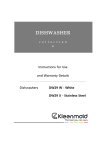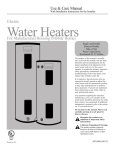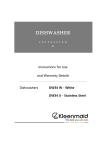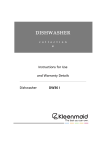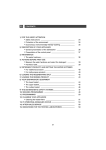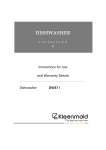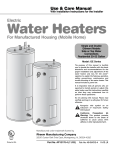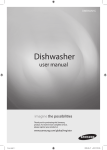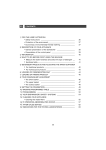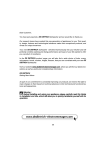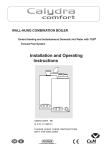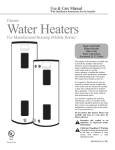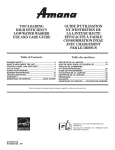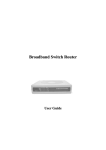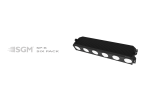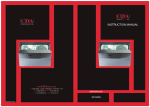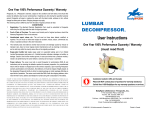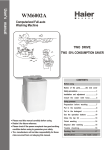Download Dishwasher
Transcript
INSTRUCTIONS FOR USE Dishwasher BLANCO BFD8XP Free Standing Dishwasher. EN CONTENTS 1/ FOR THE USER’S ATTENTION • Safety instructions ______________________________________ • Protection of the environment ____________________________ • Economical, environmentally friendly washing ________________ 2/ DESCRIPTION OF YOUR APPLIANCE • General presentation of the dishwasher ____________________ • Presentation of the control panel __________________________ 3/ INFORMATION • The water hardness______________________________________ 4/ ACTIONS BEFORE FIRST USE • Measure the water hardness and select the detergent ________ • Hardness table__________________________________________ 5/ DETERGENT PRODUCTS AND SETTING THE WATER SOFTENER • For traditional products __________________________________ • For multi-purpose products ________________________________ 6/ LOADING THE REGENERATING SALT __________________________ 7/ LOADING THE RINSING PRODUCT ____________________________ 8/ YOUR DISHWASHER’S EQUIPMENT • The lower basket ________________________________________ • The upper basket________________________________________ • The cutlery basket ______________________________________ 9/ THE DISHWASHER’S SAFETY SYSTEMS________________________ 10/ WASHING PROGRAMS______________________________________ 11/ PROGRAMMING __________________________________________ 12/ CLEANING YOUR APPLIANCE • Cleaning the waste filters ________________________________ 13/ IF OPERATING ANOMALIES OCCUR __________________________ 14/ AFTER-SALES SERVICE ____________________________________ 15/ INDICATIONS FOR THE TESTING LABORATORIES ______________ 2 3 4 5 5 6 7 8 9 9 10 11 12 13 14 15 16 17 18 20 21 23 28 29 EN EN 1/ FOR THE USER’S ATTENTION — This appliance must only be used by adults. Ensure that children do not touch it and do not use it as a toy. Ensure that they do not operate the appliance’s controls. — Keep young children away from the appliance when it is operating. — Detergents contain irritant and abrasive substances. These products can have caustic effects on the eyes, the mouth or the throat. They can be extremely dangerous if ingested. Avoid any contact with the skin and the eyes. Ensure that the appliance’s detergent container is empty at the end of the washing cycle. — Place detergents out of children’s reach and do not put any detergent in the machine until just before you start the washing programme. — The water in your dishwasher is not drinking water; this is why children must not go near the appliance when its door is open. — Do not let your children play or sit on the door when it is open. — Once you have unpacked your appliance, place the packaging out of children’s reach. — Keep all the packaging materials (e.g. plastic bags, polystyrene, etc.) out of children’s reach because they can be dangerous for children (ie. risk of suffocation). Important : Keep this user’s manual with your appliance. If the appliance is sold or transferred to someone else, ensure that the manual is with it. Please take note of these instructions before installing and using your appliance. They have been drawn up for your own and other people’s safety. • SAFETY INSTRUCTIONS • Installation — When you receive your appliance, unpack it or have it unpacked immediately. Check that it has not suffered any damage during transport. Express any reservations in writing on the delivery note, of which you keep a copy. Never connect up a damaged machine. If your appliance is damaged, please contact your dealer. — Before proceeding to connect up your machine, please refer to the instructions in your Installation Guide. — Your dishwasher must be kept disconnected from the mains supply throughout the whole of the installation process. — The electrical connection details on your appliance’s description plate must comply with those for the mains supply. — The socket must still be accessible once your appliance has been installed. — Do not alter or attempt to alter the appliance’s characteristics. This could put you at risk. — If your installation has to be altered, only entrust the electrical and plumbing work to a qualified electrician or plumber respectively. — Your appliance is designed for normal domestic use. Do not use it for industrial or commercial purposes or for any other purpose than that for which it has been designed. — The dishwasher’s walls must not be pierced under any circumstances. • Use — This appliance is not intended for use by persons (including children) with reduced physical, sensory or mental capabilities, or lack of experience and knowledge, unless they have been given supervision or instruction concerning use of the appliance by a person responsible for their safety. — When machine is running, do not open door. This may provoke steam leakage or splattering of water. -- If the dishwasher is not being used for long periods of time, turn the electricity and water supply to the dishwasher off. -- If the supply cord is damaged, it must be replaced by the manufacturer or its service agent or a similarly qualified person in order to avoid a hazard. • Children’s safety — This appliance is not intended for use by young children or infirm persons unless they have been adequately supervised by a responsible person to ensure that they can use the appliance safely. 4 1/ FOR THE USER’S ATTENTION -- The dishwasher must always be connected to the water system using new hose sets. -- If the appliance is installed on a carpet floor, take care that the openings in its base are not obstructed -- Only use products specially designed for your dishwasher (water softening salt, detergent and rinsing products). — As far as possible, avoid opening the dishwasher’s door when it is operating, and in particular during the heating phases, because scalding steam may escape or you may be splashed with hot water. The machine is fitted with a safety system that immediately blocks the dishwasher’s operation if the door is opened. — Never use chemical solvents in your appliance because these could cause an explosion. — Always close your appliance’s door after loading or removing your items. — Do not lean or sit on your appliance’s door when it is open. — You are strongly advised to disconnect the machine after use and turn off the water supply. — Unplug your machine before carrying out any technical work on it. — Avoid placing your machine immediately next to a cooking or heating appliance to prevent any risk of heat damage; — Do not place any items in your machine, which are not certified as dishwasher safe. — If you have removed an item before the end of the washing programme, it is important to rinse it carefully to remove any residual washing products. — If your appliance breaks down, never attempt to repair it yourself. Any repairs made by non-qualified personnel can cause significant damage or lack of control. — The machine complies with applicable safety regulations. Any repairs should be carried out by qualified technicians. Repairs or changes that do not conform may be dangerous for the users. In case of replacement, only use original parts. — If the machine malfunctions due to other causes than those mentioned in this booklet, disconnect the machine (remove the plug) or break the circuit concerned and contact your nearest service provider. • ENVIRONMENTAL PROTECTION This appliance’s packaging material is recyclable. Help recycle it and protect the environment by dropping it off in the municipal receptacles provided for this purpose. Your appliance also contains a great amount of recyclable material. It is marked with this label to indicate that in countries that are a members of the European Union the used appliances should not be mixed with other waste. This way, the appliance recycling organised by your manufacturer will be done under the best possible conditions, in compliance with European Directive 2002/96/EC on Waste Electrical and Electronic Equipment. Contact your town hall or your retailer for the used appliance collection points closest to your home. We thank you doing your part to protect the environment. • ECONOMICAL, ENVIRONMENTALLY FRIENDLY WASHING — Remove any food residue from your crockery (bones, pips, etc.) — Do not pre-wash your items by hand (useless waste of water). — Utilise your dishwasher’s capabilities to the full for an economical, environmentally friendly wash. — Always select a washing programme suitable for the crockery type and how dirty they are. — Avoid overdosing with detergent, regenerating salt and rinsing liquid. Follow the recommendations in this guide (pages 9-10-11) and the instructions on the product packs. — Ensure that the water softener is correctly set (see pages 10-11). 5 EN EN 2/ DESCRIPTION OF YOUR APPLIANCE • GENERAL PRESENTATION OF THE DISHWASHER 2/ DESCRIPTION OF YOUR APPLIANCE • PRESENTATION OF THE CONTROL PANEL C BLANCO A Fig. 02 70°C A 65°C 55°C 50°C 45°C B D E F B A On/Off: Press this button to start your dishwasher : the screen lights up. C D E F G H I F Start/C: Briefly press this button to start your programme. If you make an error, to cancel a selection or cancel a programme while it is running, hold down this button for 3 seconds. C AUTO: Press this button to select the Automatic programme. The indicator lights: Salt: B Programme selector: Briefly press one button or the other in succession to select your programme. lit; indicates lack of regenerating salt. Rinsing liquid: lit; indicates lack of rinsing product. Fig. 01 A D Set: • Set the water softerner. Upper basket F Waste filter B Washing products dispenser G Main filter C Anti-blocking gauge wire H Rinsing product dispenser E Selection of washing with a Delayed Start: D Lower sprinkler arm I Description plate (After-Sales Ref) Press this button to delay the programme by 3, 6 or 9 hours. E Regenerating salt tank Advice : This user’s guide is applicable to several models. There may be some slight differences in the details and the equipment between your appliance and the descriptions provided here. 6 Multi-purpose products: lit; shows you that the “4/1” feature is turned on and that the programmes are now automatically adjusted if a multi-function tablet is used. (See 5/ Detergent products and setting the water softener). Programme underway Time remaining: 45’ - 15’ End: End of programme. Advice : A short audible signal (beep) confirm the button’s selection, except for the “On/Off” button. 7 EN EN 3/ INFORMATIONS Important: For impeccable results, preferably use a combination of traditional products: ① Washing detergent to clean the For your dishwasher to provide impeccable washing and drying results with no marks, you must set it correctly using the water softening system, which uses regenerating salt (rock salt). crockery perfectly (powder, liquid or standard tablets). ② Regenerating salt (rock salt).to enable your dishwasher’s water softener to operate correctly. • THE WATER HARDNESS • Lime: rainwater filtering through the ground picks up mineral salts; some minerals are found in solid form commonly termed lime. This reduces the washing detergent’s performance, furs up the dishwasher and leaves white marks on the crockery. The more lime there is in the water, the more the water is called “hard”. 4/ ACTIONS BEFORE FIRST USE • MEASURE THE WATER HARDNESS AND SELECT THE TYPE OF DETERGENT: TRADITIONAL OR MULTI-PURPOSE In one simple action, you can test the your water’s lime content using the testing strip supplied with your dishwasher. Alternatively, contact your local water utility to ascertain your water’s hardness. — Let the water run from the tap for a few moments. — Fill a glass with water. — Take the test strip from its holder and immerse it for 3 seconds. — Wait 1 minute, shake it and look at the colours to ascertain your water’s hardness. ③ Rinsing liquid to assist drying and to eliminate marks from water droplets. Important: Never use washing-up liquid. • HARDNESS TABLE Use the most suitable products for the level of water hardness in your town. There are several types of products; how to choose: For ease of use and only in certain water hardness conditions < 25°F, multi-purpose products may make the use of rinsing liquid or salt unnecessary. • “Two-in-one” products contain detergents, rinsing liquid or an agent acting as the salt. • “Three-in-one” products contain detergents, rinsing liquid and an agent acting as the salt. • “Four-in-one” products also contain additives that prevent wear on poor quality glasses and /or prevent the risks of the stainless steel corroding. Test strip Follow the instructions for using the multi-purpose product and the recommendations on the pack. NB: If in any doubt, please contact the detergent manufacturer if the crockery is very wet at the end of the programme or if chalky deposits appear. 8 0-10°F Soft Possible use of traditional products ➊ ➊ Important: > 70°F 10-18°F 18-25°F 25-40°F 40-55°F 55-70°F Very hard Slightly hard Slightly hard Hard Hard Hard Essential if Essential if Optional using traditional using traditional Mandatory Mandatory Mandatory Mandatory products products Hardness Water Water softening and use of salt or ➋ or + or Use only of traditional products ➊ + R or Multi-purpose or + ➋ ➊ Traditional products: P : Powder detergent or L : Liquid detergent or + S : Regenerating Salt + R : Rinsing product ➋ Multi-purpose products: Multi-purpose tablets 9 single tablet + R EN 5/ DETERGENT PRODUCTS AND SETTING THE WATER SOFTENER • FOR STANDARD WASHING PRODUCTS • Your machine must be specially adjusted to use standard washing products. • Proceed as follows to adjust the water softener on the control panel: — This setting is made using the “SET” button; hold down the button to access the menu; the programme and delayed start lights light up. — The softener setting is indicated by the programme lights. — To modify this setting (depending on water hardness) press either button several times. — Your choice is confirmed automatically after about 10 seconds without pressing “SET”. — Pressing “SET” confirms the setting. 70°C Testing strip Hardness 65°C 55°C 50°C 45°C Softener setting 0-10°F 70°C 10-18°F 70°C 65°C 55°C 50°C 45°C 18-25°F 70°C 65°C 55°C 50°C 45°C 25-40°F 70°C 65°C 55°C 50°C 45°C 40-55°F 70°C 65°C 55°C 50°C 45°C 55-70°F 70°C 65°C 55°C 50°C 45°C > 70°F 70°C 65°C 55°C 50°C 45°C 65°C 55°C 50°C Important : 45°C For hardness settings less than 25°F (“4 in 1” light lit up or flashing) where you are using multi-function products, please refer to the table on the next page to get the most from the “4 in 1” option setting (optional). Light unlit : Light permanently lit : Light flashing : Important: It is very important to set the water softener correctly. - If the setting is too low, there is the risk of chalky marks appearing. - if the setting is too high, there is the risk of causing clouding of the glasses. If you relocate, adjust the water softener setting as required. • standard washing tablets Non-multipurpose tablets should be placed in the external compartment (Fig 04) or, for optimum performance, pull out the dispenser drawer and lay the tablet inside (Fig 05). • Powders or liquids (Fig 03) Fill at least up to the minimum mark for slightly dirty crockery and to the maximum mark for dirty crockery. If the crockery is very dirty and for programmes with a pre-wash we recommend that you add 5g of detergent (a dessert spoonful) into your dishwasher’s tub in accordance with the programmes table. Important: Keep these products out of children’s reach and away from dampness. Only use products specially designed for dishwashers. EN 5/ DETERGENT PRODUCTS AND SETTING THE WATER SOFTENER • FOR MULTI-PURPOSE PRODUCTS (Water hardness less than at 25°F) • Your appliance automatically adapts to using multipurpose products when the water hardness is less than 25°F. • Proceed to set the water softener — This setting is made using the “SET” button; hold down the button to access the menu; the programme and delayed start lights light up. — The softener setting is indicated by the programme lights. — In order to use multi-function tablets, you will need to change this setting. To modify this setting, press either of the selection buttons several times until you have selected the correct setting to match the water hardness. • Proceed to set the “Multi-prupose products — Hold down the “S ET ” button until the “ selection buttons . — ” (function (optional) ” light flashes, then press one or other of the (Light unlit) : deactivates the “Multi-purpose products” option. — (Light flashing): corresponds to activation of the “Multi-purpose products” function with the setting for “ S p a r k l i n g C l e a n ” . This enables you to prioritise a brilliant finish for your crockery. — (Light permanently lit) : corresponds to activation of the “Multi-purpose products” function with the setting for “Extra Dry”. “ E x t r a d r y ” enhances the drying results if performance is reduced. — The setting is validated automatically after 10 seconds if the “ S ET ” button in not pressed again. — The “Multi-purpose products ” light then illuminates permanently if this option has been selected. Testing strip Hardness Multi-purpose products Sparkling “S Function Extra Dry” “E Deactivated Clean” Softener setting 0-10°F 70°C 65°C 55°C 50°C 45°C 10-18°F 70°C 65°C 55°C 50°C 45°C 18-25°F 70°C 65°C 55°C 50°C 45°C • Loading the multi-purpose tablet dispenser To assist in loading the detergent, the distributor is situated on the front of the upper basket. It is compatible with all the products recommended for dishwashers. • Place the tablet in the external compartment (Fig 04 on previous page) or, for optimum results, pull out the distributor’s drawer and lay the tablet inside (Fig 05 on previous page). - Close the dispenser. Fig. 03 Fig. 04 Fig. 05 10 11 EN EN 6/ LOADING THE REGENERATING SALT • Loading the regenerating salt 7/ LOADING THE RINSING PRODUCT • The rinsing product (Fig. 07) (Fig. 06) Important: Important : Only use special dishwasher regenerating salt. Do not use table salt or any type of cooking salt: this could damage your appliance’s water softener. Use a special dishwasher rinsing product; this will give you dry, sparkling crockery. A A A B Before switching on the appliance, fill the rinsing product container until the level is flush with the top of the setting lever. SE L A Unscrew and remove the stopper on the salt tank. B Fill the tank with regenerating salt specially designed for dishwashers. C Use the funnel supplied with your dishwasher. The first time, top up with water up to the rim of the tank. Adjust, if necessary; the original setting is 2. If you experience poor drying or residual marks after a few cycles, increase the setting by turning the lever (fig 07 C : marking 3 to increase it) B • Checking the level of rinsing liquid : This lights when rinsing liquid must be added. • Regenerating salt indicator : EAU 12 3 This illuminates when salt must be added. After the tank has been filled with regenerating salt, the indicator light may remain lit until the salt has dissolved sufficiently, usually after one cycle (of if the tank has not been filled completely; for example, when first putting the machine into service using the sample). B Important: C If any rinsing liquid overflows onto the door when filling the container, sponge away the excess to avoid foam forming. Fig. 06 3 12 Important : C If the salt overflows when filling the tank, to avoid oxidization of the tub it is advisable to remove the salt crystals or to run a Soaking programme. Fig. 07 12 13 Adjustment lever EN 8/ YOUR DISHWASHER’S EQUIPMENT Very important : Items not suitable for washing in a dishwasher - Wooden cutting boards, - Stainless steel utensils or plastic utensils that are not heat-resistant, - Copper or pewter items, - Glued crockery and cutlery, - Cutlery with wooden, horn or mother-of-pearl handles, - Antique or hand-painted porcelain. When purchasing crockery, glasses or cutlery, ensure that it is dishwasher-safe. • THE LOWER BASKET EN 8/ YOUR DISHWASHER’S EQUIPMENT • THE UPPER BASKET This basket is particularly designed to take: glasses, cups, ramekins, small salad bowls, bowls, saucers, etc... Arrange your items methodically to save on space (arranging glasses, cups or bowls together, etc.) You can also arrange cups, ladles, etc. on the retractable supports (Fig. 10) Advice : Arrange your items so that the water can circulate freely and spray over all the utensils. Place large diameter dishes and pans at the sides. Do not intersperse, jam together or superimpose flat plates and concave dishes (Fig. 08). The folding spikes make it easier to arrange your large dishes (Fig. 09) (depending on the model). Position the cavities of glasses, cups or bowls facing downwards. Cutlery basket Fig. 10 • Adjusting the height of the upper basket (depending on the model) Advice : When you re-insert the lower basket, ensure that nothing catches on the upper basket’s gauge wire to avoid blocking the rotor. Fig. 08 Unloading your items First of all empty the lower basket to avoid drips from the upper basket falling onto the lower basket. For large dishes to be loaded in the lower basket, the upper basket must be set in to high position. This can be done with the basket fully loaded (Fig. 11) ① Setting in HIGH POSITION : Gently raise your basket on each side until it engages. Fig. 11 ② Setting in LOW POSITION : Raise your basket completely on both sides to unlock it and then lower it to the low position. Fig. 09 Important : Check that the two slides are set to the same height and the basket is horizontal. 14 15 EN 8/ YOUR DISHWASHER’S EQUIPMENT EN 9/ THE DISHWASHER’S SAFETY SYSTEMS • Door not closed properly • THE CUTLERY BASKET The light flashes when the door is open or not closed properly. • Anti-overflow system The cutlery basket slides to allow for modulable loading. It can be placed anywhere in the lower basket. You can therefore make a variety of loads depending on the items (Fig. 12). This system automatically activates the drain pump if the water level in the tub reaches an abnormal height. • Anti-leak system This system interrupts the water supply if a leak is detected under the appliance. If your cutlery items or your dishes are too large, alter the height setting for the upper basket (if it can be adjusted, depending on the model). • If an anomaly occurs The “End” light flashes rapidly. The four lights 70°C Fig. 12 65°C 55°C 50°C 45°C indicate the anomaly as per the table on page 23. Movable grills are available for if you wish to load your cutlery in an orderly manner (Fig. 13). For optimum washing and drying, use these separation grills partially or totally. Point the handles on the cutlery downwards. Important : Fig. 13 For safety reasons, we recommend that you place knives with pointed ends with the point facing downwards in the cutlery basket (to avoid the risk of an accident). Long-bladed knives and other sharp kitchen utensils must be placed flat in the upper basket. Avoid washing cutlery with horn handles in your dishwasher. Separate silverware from other metals using the separation grill. 16 17 EN EN 10/ WASHING PROGRAMS 10/ WASHING PROGRAMS • PROGRAMS TABLE Type of items: - porcelain, pans, cutlery, glasses, etc. Quantity, type and amount of food residue. Programmes Programme sequence Resistant Mixed Mixed Mixed Mixed Mixed Mixed Very dirty large dishes and pans, with baked on residue, grease, cooked cheese, sauce, etc. Normally dirty A normal amount of dried-on and greasy residue on everyday items. Faster, but consumes more energy. Normally dirty, i.e. a normal amount of sticky and greasy residue. A longer programme because it saves on energy. Normally dirty Washing at low temperature, economical and particularly suitable for compact – enzymatic detergents Very short 30minute wash specially designed for a small amount of daily items with a limited amount of non-greasy residue, not dried on Very short cycle (with no detergent) for rinsing and re-dampening the items while waiting for a wash expected the following day or even the day after AUTO Intensive 70°C Universal 65°C 55°C Normal Eco 50°C Quick 45°C Soaking Pre-wash AUTO Pre-wash Hot pre-wash Pre-wash Pre-wash Washing at 70°C Washing at 65°C Washing at 55°C Washing at 50°C Washing at 45°C Washing at 55/65°C Rinse Rinse Rinse Rinse Rinse Rinse Hot rinse Hot rinse Hot rinse Hot rinse Hot rinse 60°C Hot rinse Natural Drying Natural Drying Natural Drying Natural Drying Natural Drying Natural Drying 120’-140’ 14,5 - 16,5 l. 1,7-1,8 kWh 90’-120’ 14,5 - 16,5 l. 1,5-1,6 kWh 130’-150’ 14,5 - 16,5 l. 1,3-1,4 kWh 120’-145’ 13.9-15 l. 0,94-1,3 kWh 30’ 11 0,8 kWh As an indication only: Duration in min Water (l.) Energy (kWh) Eco Automatic detection of the amount of residue. Optimises the results and prioritises energy savings. 15’ 4,5 l. 0,02 kWh These values refer: - to normal usage conditions with separated products (detergents, salt, rinsing product). - only to multifunction product usage conditions They may vary depending on the load, the water temperature, the softener setting, the presence of rinsing product and the supply voltage. 18 19 90’ - 120’ 14,5 - 16,5 l. 1,4 - 1,6 kWh EN EN 11/ PROGRAMMING • CLEANING THE WASTE FILTERS C BLANCO Fig. 02 A 70°C 65°C 55°C 50°C ➀ The filtration system consists of several elements: A - The waste filter. 45°C B D E Advice : F Consult the Programmes table on the preceding pages to determine the programme you need for the type of items, the quantity and the amount of food residue. • Immediate programme start B - The large main filter. C - The micro filter. B A C ➁ The filters are located in the centre of the tub and must be washed regularly to obtain optimum washing results. • Actions : On/Off” A , to switch on your appliance Press “O and select your programme by pressing one button or the other or the Automatic programme by pressing the AUTO button. — When a programme is selected, the associated light illuminates. Press “Start/C” F , the “In progress” light illuminates. Close the door and the programme starts. - 45’, 15’ and End indicate the remaining time of the cycle 12/ CLEANING YOUR APPLIANCE Programme time remaining 45' End of programme End 15' ➀ Before removing the filters, remove any waste on the large main filter B with a sponge so that the waste does not block the sprinkler arms. Orient the rotor as shown in the drawing. (Fig. 14) ➁ Loosen the waste filter a quarter of a turn and then remove it A . ③ Remove the main filter B . ④ Remove the micro filter screen A ③ B C . ④ A short audible signal (beep) confirm the button’s selection, except for the “On/Off” button. ⑤ Carefully clean filters • Delayed programme start After selecting your programme, press the “Delayed Start” E button once twice or three times depending on whether you wish to delay the programme start by 3, 6 or 9 hours; the appropriate light illuminates. Confirm by pressing “Start/C”. • End of the programme 9h 6h 3h A , B and C under running water. (Fig. 15) ⑤ Reinstallation: Proceed in reverse order, inserting filters C and B and then A . A Important : The light flashes 15 minutes before the end of the programme and then lights permanents once the programme has finished. Fig. 15 Remember to lock the waste filter in A place by pushing it in fully and turning it a quarter turn. • Cancelling a programme C” F button for a few Hold down the “Start/C seconds. 20 C Fig. 14 21 B C EN 12/ CLEANING YOUR APPLIANCE • Periodically : Every 3 or 4 months, in order to remove any deposits, run a special maintenance programme, without any items in the machine, using a commercially available special dishwasher cleaning product. EN 13/ IF OPERATING ANOMALIES OCCUR • SUMMARY OF THE FAULTS Flashing LED(s) for models without a display Flashing LED(s) Important : d01 : water supply fault (tap) d07 : overflow / anti-leak fault Keep this product out of children’s reach.. d02 : draining fault d08 : sprinkling distribution fault d03 : heating fault d11 : pressure sensor fault d04 : temperature fault d12 : filling fault (water inlet detection system) d05 : faulty motor d13 : faulty heating d06 : faulty motor d14 : installation fault : (incorrect drainage connection or inadequate flow rate and tap). • Prolonged stoppage Clean your dishwasher completely and then unplug it from the electricity supply and close the water tap. Protect your machine from potential frosts Advice : Do not use abrasive powders, metal sponges and alcohol-based or thinner-based products. Use a cloth or a sponge. If you are moving house, run a soaking programme first of all, in order to avoid any water escaping. Tip: If one of the above faults occurs and you need to call a repair man, remember to tell him the message displayed (d01, d02..) as this information will help him. • BEFORE CALLING FOR SERVICE Problem Possible Causes What to do? The door falls heavily when - Door springs not tensioned - Tighten the two tensioning opened (integratable model) enough to compensate for the screws accessible in the botweight of the panel. tom section above the front feet. The door does not stay horizontal - Door springs tensioned too - Loosen the two tensioning when open or returns too quickly much. screws accessible in the bot(integratable model) tom section above the front feet. - Fit a temporary wooden panel - No wooden panel. on the appliance and adjust the springs. The door catches when closing - Appliance not stable - Door not centred on the tub - Adjust the feet. - Re-centre by adjusting the rear feet. The upper basket does not stay - Poor manipulation (the basket - Act more progressively (see in the high position is being pulled upwards too instructions), one side and quickly) then the other. Small leak around or under the - Leak from the tap. appliance (move the appliance - Leak from the appliance. to locate the leak) (Cf. table fault d07). Small leak at the door 22 - Check that a seal is fitted and retighten the nut. - Close the water tap and call a technician. - Appliance not stable or not level - Adjust the feet. - Door not centred on the tub. - Re-centre by adjusting the rear feet. 23 EN EN 13/ IF OPERATING ANOMALIES OCCUR 13/ IF OPERATING ANOMALIES OCCUR Problem • THE INDICATOR LIGHTS The appliance will not restart Problem The salt light does not go out Possible Causes The lights all light up one after - Wrong programme. the other A light flashes and the programme does not start What to do ? - No salt or an insufficient quan- - Refill the tank and wait for the tity of salt in the tank to trigger cycle to end. If you have soft the float. water that requires no salt, the light is constantly lit. - Programme selector wrongly positioned (between two notches) - Cancel the current programming by holding down the Start button for 3 seconds and then re-programme. - Reposition the selector on a programme. The appliance does not drain (Cf. table fault d02). The appliance will no longer function (see table, fault 14). • RELATING TO PROGRAMMING, DISPLAY Problem The cycle lasts too long Possible Causes What to do ? - lThe energy-saving programmes last longer because the agitation and drying times are longer to compensate for the lower washing and drying temperatures - Use these programmes preferably at night when it is not so important how long the programme lasts or when it ends. The appliance trips the circuit - Insufficient amperage to sup- - Check the socket’s amperage breaker (10A minimum) and the ply all the appliances being meter’s capacity. operated simultaneously. - Internal fault in the appliance. - Call a technician. The appliance does not start - No mains power to the socket. - Check the socket and the fuse - Tap closed. (Cf. table fault d01). - Check the tap is open. - Check the hose line is OK. - Selection error or programme - Cancel by holding down Start lock. for 3” and re-programme. - Start button pressed too long - Just press Start briefly to start (>2”). the programme. - Appliance in Safety mode (anti- Call a technician. leak).(Cf. table fault d07). 24 Possible Causes What to do? - Door opened during a washing cycle. - Wait for the time delay to end (controlled internally by the appliance). - The cover has not been remo- - Remove the cover. ved from the sink’s U-bend. - Drain hose kinked. - Check the drain hose line behind the machine is OK. - Filters totally blocked. - Remove and clean the filters and the drain. - Initiate a Soaking programme - Pump blocked. If the fault persists, call a technician. - installation of non-compliant drai- - adhere to the drainage tube nage system: drainage too low installation dimensions. down or pipe pushed too far in. - siphoning: the appliance is emptying as the same time as it is filling up. • POOR WASHING RESULTS Problem Possible Causes What to do? Food traces and deposits in the - Items poorly arranged (mas- - Arrange the items properly. glasses ked by another larger item or Use the most appropriate situated underneath it, items areas and accessories for each nested or jammed together). type of item (see instructions). - Upper spray arm blocked by - Check that the spray arm cutlery or a dish etc. rotates freely. Set the basket in the high position if necessary. - Check the filter’s facing and that - Filter poorly locked and lifting the filter is locked in place (push it in fully, turning it to the right). during washing. - Remove all the filters and clean them (in warm water), including - Micro filter screen clogged. the micro filter’s screen (once a month). - Remove the spray arm by turn- One or more holes in the spray ing the lever a quarter of a turn and clean it under the tap (do arm blocked. not use any tool that could damage the holes). Re-install the spray arm. Traces of grease - Detergent dose too low; ineffi- - Increase the dose; try another cient detergent; stale product. detergent. - Inappropriate programme - Select a programme with a (temperature too low; duration higher temperature. too short). 25 EN EN 13/ IF OPERATING ANOMALIES OCCUR • POOR WASHING RESULTS... White marks (identify what type) White marks (identify what type) • POOR OPERATION - Chalky film (removable with - Check that there is salt in the vinegar). tank (light unlit = OK). - Check the water hardness at the tap and that the water softener is set correctly. Adjust it to a higher level if necessary. - Water too hard for using a “4in-1” detergent without the - Traces of salt (items have a addition of salt. - Check that the stopper on the salty taste). salt container is closed correctly. - Glass cloudy because water - Check the water hardness at too soft (cannot be removed). the tap and that the water softener is set correctly. Some detergents in pellet form are more aggressive to glasses and decorations (change the product and use a protective product if necessary). Coloured marks (tea, wine, cof- - Items poorly arranged - Turn the cavities in the items fee) - Detergent dose too low ; inef- towards the jets. ficient detergent - Increase the dose; try another - Programme temperature too detergent. low. - Select a more suitable programme with a higher temperature. - If you use a multifunction - Use the “4-in-1” option. product. (depending on the model). Streaks or dried droplets on - Lack or insufficient amount of - Check the indicator light and fill the tank completely. Adjust glasses rinsing product. the dispensing unit to a higher position if necessary. - Rinsing product out-of-date or - Use a recent product (a good product dilutes easily and inefficient. foams in cold water). - Use the “4-in-1” option with a - If you use a multifunction setting prioritizing drying product. (parametering from the menu depending on the model). Dried-on marks on glasses, dullness 13/ IF OPERATING ANOMALIES OCCUR - If you use a multifunction product. 26 - Use the “4-in-1” option with a setting prioritizing brilliance (parametering from the menu depending on the model). Problem Possible Causes What to do ? Constant filling - (Cf. table fault d12). Drain hole - Drain wand fallen on the floor. situated too low for the appliance. A lot of waste on the large filter - The filters and drain outlets are - Remove and clean the filters blocked with too much and the bottom of the drain at the end of the cycle. residue. outlets. Remove large residue from the plates before putting them in the machine. Traces of rust on stainless steel - Quality of the stainless steel - Use “special dishwasher-safe” not dishwasher-safe (knives in cutlery. - Check that the stopper on the particular) salt container is closed correctly. • POOR DRYING RESULTS Problem Possible Causes What to do? A lot of droplets on the glasses. - Lack or insufficient amount of - Check the indicator light and rinsing product. fill the tank completely. - The dose has not been distrib- - If the tank is not empty after uted. approximately 60 washings, call a technician. - Positioning of the items. - To alleviate the phenomenon, arrange the items to restrict water retention as much as possible. Leave the door ajar for a few minutes, if possible Droplets on plastic items, Tefal - These insulating items have a - Arrange them preferably in the coatings, etc. low calorific mass. upper basket. Poorer drying on rapid programmes - On rapid programmes, the drying - Select a rapid programme temperature and drying period are carefully or leave the door ajar reduced to cut down the duration for a few minutes. of the cycle as much as possible. Condensation on the wall of the - Condensation may form on the inside door or the tub. walls, particularly after the appliance has cooled down (sound insulation increases the phenomenon) 27 EN EN 14/ AFTER-SALES SERVICE 15/ INDICATIONS FOR THE TESTING LABORATORIES 50°C • INTERVENTION WORK ENERGY EFFICIENCY TESTS ACCORDING TO AS/NZS 2007 PROGRAMME : Normal Eco — Washing capacity - - - - - - - - - - - - - - - - - - - - - - - - - - - - - - - - - - - 13 standard place settings Figs. A-B-C; IEC load (next page) — Arrangement of the items - - - - - - - - - - - - - - - - - - - - - - - - - - - - — Loading as per the indications on next page, with one or two side shelves, without stemmed glass support, and with 5 cup/saucer supports (4 for 13 saucers & 1 for 2 cups) — Setting for upper basket - - - - - - - - - - - - - - - - - - - - - - - - - - - - - Low position — Dosage of detergent - - - - - - - - - - - - - - - - - - - - - - - - - - - - - - - 5 + 26.25 g of detergent — Setting for rinsing product distributor - - - - - - - - - - - - - - - - - 2 — The water softener must be set to 0-10°F instructions in the paragraph on “Adjusting the water softener”. — Door ajar 100 mm upon completion of dry test. Any intervention work on your appliance must be performed by a qualified professional approved by the manufacturer. When you call, please mention the full reference for your appliance (model, type and serial number). This information is shown on the description plate (see Fig. 16) ORIGINAL PARTS When maintenance is being carried out, ask for only certified original spare parts to be used. For more information on the comparison tests in accordance with AS/NZS 2007, please contact the manufacturer of the machine before commencing testing. NB: When conducting tests using a multi-function tablet: - Check that the water softener is correctly set for the water hardness (Chapter 5 / DETERGENT PRODUCTS AND ADJUSTING THE WATER SOFTENER • FOR MULTI-FUNCTION PRODUCTS) - Pull out the detergent distribution drawer and place the tablet in the interior compartment. Fig. 16 28 29 15/ INDICATIONS FOR THE TESTING LABORATORIES : AS/NZS LOAD EN EN 15/ INDICATIONS FOR THE TESTING LABORATORIES : IEC LOAD A A B 1 2 3 4 2 2 2 2 2 2 5 5 5 5 5 5 5 1 1 1 1 1 1 B 2 2 2 2 2 2 1 NOK NOK OK C 4 44 NOK 33 3333 3 33 3 NOK 2 3 OK 5 5 5 5 1 1 1 1 1 1 5 3 33 33 3333 3 33 3 111 2 5 5 5 2 111 111 2 5 5 5 2 111 222 5 5 5 5 221 222 5 5 5 5 221 444 4 4 4 4 44 4 444 4 4 4 4 44 4 333 C 30 4 5 5 31 444
















